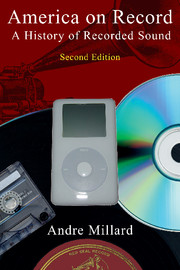Book contents
- Frontmatter
- Dedication
- Contents
- Preface to the second edition
- Preface to the first edition
- Introduction
- Part One The acoustic era
- Part Two The electrical era
- 6 The machines
- 7 Competing technologies
- 8 Empires of sound
- 9 Swing and the mass audience
- 10 High fidelity at last
- 11 Rock'n'roll and the revolution in music
- 12 The record
- 13 The studio
- 14 Perfecting studio recording
- 15 The cassette culture
- Part Three The digital era
- Abbreviations used in the notes
- Notes
- Select discography
- Select bibliography
- Subject index
- Recordings index
- Motion picture index
10 - High fidelity at last
from Part Two - The electrical era
Published online by Cambridge University Press: 05 February 2015
- Frontmatter
- Dedication
- Contents
- Preface to the second edition
- Preface to the first edition
- Introduction
- Part One The acoustic era
- Part Two The electrical era
- 6 The machines
- 7 Competing technologies
- 8 Empires of sound
- 9 Swing and the mass audience
- 10 High fidelity at last
- 11 Rock'n'roll and the revolution in music
- 12 The record
- 13 The studio
- 14 Perfecting studio recording
- 15 The cassette culture
- Part Three The digital era
- Abbreviations used in the notes
- Notes
- Select discography
- Select bibliography
- Subject index
- Recordings index
- Motion picture index
Summary
Despite the depressed economic environment of the 1930s, the technology of the electrical era was continually improved. The concerted attention of well-financed corporate laboratories, the exchange of ideas between the three business endeavors employing recorded-sound technology (talking machines, radio, and talking pictures), and the international diffusion of technology across the Atlantic were the forces of this endeavor.
The film industry led the way in improving the electrical recording system devised in Western Electric's laboratories. One element of this system which benefitted from the diffusion of ideas from one business enterprise to another was the dynamic loudspeaker.
The great movie palaces built in the late 1920s contained thousands of seats, and very large loudspeakers were required to fill these auditoriums with sound. The loudspeakers also needed to catch every note played by large orchestras and to convincingly re-create the sound of gun shots or melodramatic screams. Consequently the leading edge of loudspeaker design was in film theaters. Research carried out in Western Electric's laboratories was supplemented by the more practical work of the engineering departments of film companies. Western Electric staff found themselves working for film producers, making up loudspeakers in studio workshops. They experimented with various configurations of transducers and with the baffles and sound insulation of the cabinet.
In 1931 the first three-way speaker systems were introduced in which sound was divided up into high, middle, and low frequencies, and each band was sent to three different transducers in the loudspeaker, each one designed to work best with that part of the sound spectrum: the large “woofer” for the bass, a mid-range driver, and the tiny “tweeter” for the treble. This technology eventually diffused to the talking-machine industry and by the 1960s was incorporated into the loudspeakers used in home stereos.
The Western Electric system was exported to film producers and record companies in Europe, where it was eagerly examined. European operators had every incentive to improve it; the license fee paid to Western Electric was motivation enough to develop their own electrical recorders based on Maxfield and Harrison's pioneering work but without infringing on their valuable patents.
- Type
- Chapter
- Information
- America on RecordA History of Recorded Sound, pp. 189 - 222Publisher: Cambridge University PressPrint publication year: 2005



